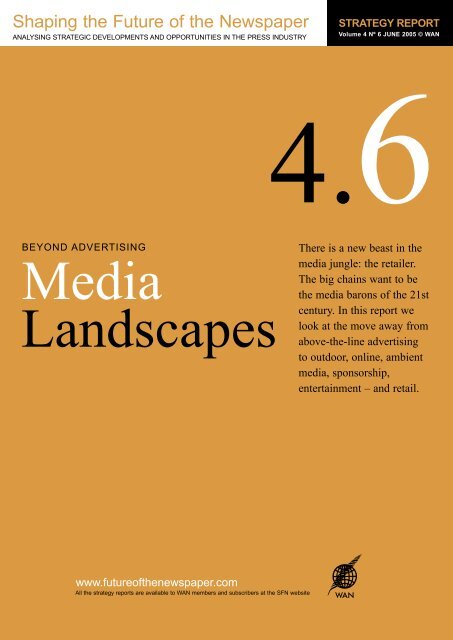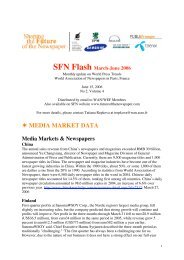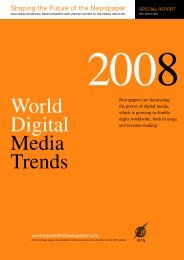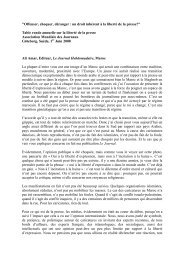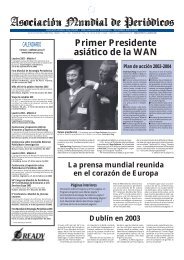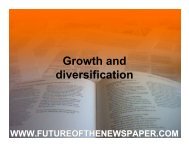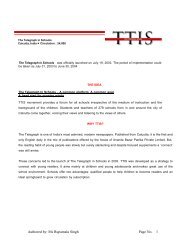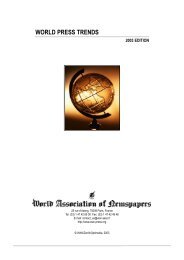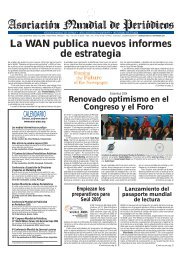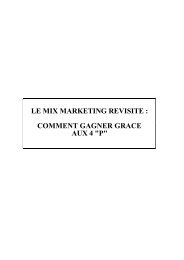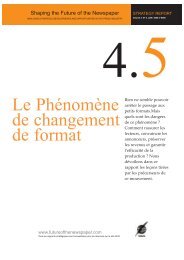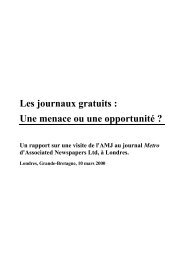Shaping the Future of the Newspaper - World Association of ...
Shaping the Future of the Newspaper - World Association of ...
Shaping the Future of the Newspaper - World Association of ...
You also want an ePaper? Increase the reach of your titles
YUMPU automatically turns print PDFs into web optimized ePapers that Google loves.
<strong>Shaping</strong> <strong>the</strong> <strong>Future</strong> <strong>of</strong> <strong>the</strong> <strong>Newspaper</strong><br />
ANALYSING STRATEGIC DEVELOPMENTS AND OPPORTUNITIES IN THE PRESS INDUSTRY<br />
STRATEGY REPORT<br />
Volume 4 Nº 6 JUNE 2005 © WAN<br />
4.6<br />
BEYOND ADVERTISING<br />
Media<br />
Landscapes<br />
There is a new beast in <strong>the</strong><br />
media jungle: <strong>the</strong> retailer.<br />
The big chains want to be<br />
<strong>the</strong> media barons <strong>of</strong> <strong>the</strong> 21st<br />
century. In this report we<br />
look at <strong>the</strong> move away from<br />
above-<strong>the</strong>-line advertising<br />
to outdoor, online, ambient<br />
media, sponsorship,<br />
entertainment – and retail.<br />
www.future<strong>of</strong><strong>the</strong>newspaper.com<br />
All <strong>the</strong> strategy reports are available to WAN members and subscribers at <strong>the</strong> SFN website
A WORLD ASSOCIATION OF NEWSPAPERS PROJECT,<br />
SUPPORTED BY WORLD-LEADING BUSINESS PARTNERS:<br />
A LEADING COMPANY FOR NEWSPAPER PRODUCTION SYSTEMS.<br />
THE SWITZERLAND BASED INTERNATIONAL ADVERTISING<br />
AND PROMOTION GROUP.<br />
ONE OF THE WORLD’S LEADING PRINTING PAPER PRODUCERS.<br />
THE LEADING NORWEGIAN TELECOMMUNICATIONS, IT AND MEDIA GROUP.<br />
A GLOBAL LEADER IN SEMICONDUCTOR, TELECOMMUNICATIONS,<br />
AND DIGITAL CONVERGENCE TECHNOLOGY.<br />
© WORLD ASSOCIATION OF NEWSPAPERS 2005
BEYOND ADVERTISING<br />
Media<br />
Landscapes
JUNE 2005 SHAPING THE FUTURE OF THE NEWSPAPER<br />
4
VOLUME 4 REPORT Nº 6 BEYOND ADVERTISING: MEDIA LANDSCAPES<br />
Foreword<br />
BY THE end <strong>of</strong> 2004, <strong>the</strong> biggest British<br />
supermarket chain, Tesco, had installed its<br />
own television network in 100 stores, with<br />
300 more in <strong>the</strong> pipeline.<br />
The company that reaped £2 billion in<br />
pr<strong>of</strong>it for <strong>the</strong> first time this year bullishly<br />
wooed advertisers. “As <strong>the</strong> country’s No.<br />
1 supermarket, Tesco is in an unparalleled<br />
position to communicate with customers<br />
without <strong>the</strong> intrusion and confusion associated<br />
with o<strong>the</strong>r media streams,” explained Tim<br />
Mason, <strong>the</strong> company’s marketing director.<br />
On average, <strong>the</strong>re is a 13-hour time<br />
lapse between a consumer watching an<br />
advertisement and visiting a supermarket,<br />
The Sunday Times reported. Tesco TV allows<br />
advertisers to reach customers at <strong>the</strong> very<br />
moment <strong>the</strong>y are making buying decisions.<br />
“The closer <strong>the</strong> advertisement is to <strong>the</strong> point<br />
<strong>of</strong> purchase <strong>the</strong> more likely you are to be<br />
successful,” Mr Mason told The Sunday<br />
Times.<br />
He’s dead right, <strong>of</strong> course. “You can’t get<br />
more targeted than when <strong>the</strong> person is about<br />
to buy,” agrees Tamar Kasriel, head <strong>of</strong><br />
knowledge venturing at <strong>the</strong> Henley Centre<br />
in London, although she believes <strong>the</strong> content<br />
is still quite primitive. Even so, up to 90 per<br />
cent <strong>of</strong> purchase decisions can be made in<br />
store, which makes Tesco TV potentially a<br />
very powerful medium.<br />
In this report, Caroline Foster Kenny <strong>of</strong><br />
Mediaedge:cia describes how that in this age<br />
<strong>of</strong> fragmented media <strong>the</strong> supermarkets, such<br />
as Wal-Mart and Tesco, are <strong>the</strong> new media<br />
barons.<br />
As communications planner John Griffiths<br />
said <strong>of</strong> <strong>the</strong> supermarkets: “They don’t have<br />
customers, <strong>the</strong>y have audiences. And store<br />
magazines and in-store TV are <strong>the</strong> trappings<br />
<strong>of</strong> media ownership.”<br />
But <strong>the</strong> rise <strong>of</strong> <strong>the</strong> supermarket goes much<br />
fur<strong>the</strong>r. The retailer exerts power over <strong>the</strong><br />
manufacturer.<br />
“The balance <strong>of</strong> power has moved quite<br />
considerably,” explains Mark Gallagher <strong>of</strong><br />
media agency Manning Gottlieb OMD in<br />
London. “It used to be <strong>the</strong> Unilevers and<br />
5
JUNE 2005 SHAPING THE FUTURE OF THE NEWSPAPER<br />
Procter & Gambles <strong>of</strong> this world that called<br />
<strong>the</strong> shots over <strong>the</strong> supermarkets because <strong>the</strong>y<br />
were <strong>the</strong> brands <strong>the</strong> supermarkets wanted.<br />
Because <strong>the</strong> supermarkets have got much<br />
bigger, <strong>the</strong> balance <strong>of</strong> power has shifted to<br />
<strong>the</strong>ir side.”<br />
<strong>Newspaper</strong>s in <strong>the</strong> United Kingdom, which<br />
have dramatically increased <strong>the</strong> number <strong>of</strong><br />
copies <strong>the</strong>y sell at <strong>the</strong> checkout in <strong>the</strong> past<br />
decade, have not yet reported problems<br />
dealing with <strong>the</strong> supermarkets. Not <strong>the</strong> case<br />
for magazines. In <strong>the</strong> United States, Wal-<br />
Mart “told Cosmopolitan to remove cover<br />
billings about abortion. It has delisted <strong>the</strong> lad<br />
mags Maxim, FHM and Stuff, and banned an<br />
album by Sheryl Crow, which criticised Wal-<br />
Mart for selling guns”, according to left-wing<br />
columnist George Monbiot.<br />
Monbiot asks whe<strong>the</strong>r <strong>the</strong> tough stance<br />
retailers take with <strong>the</strong>ir suppliers “will come<br />
to govern <strong>the</strong> superstores’ relationships<br />
with newspapers and magazines. If you<br />
doubt this, try to picture a newspaper being<br />
sold beside <strong>the</strong> Tesco checkout with <strong>the</strong><br />
headline ‘Tesco’s bullying tactics exposed’.”<br />
(Although it should be pointed out that<br />
Monbiot was writing in The Guardian, whose<br />
chief executive had recently joined <strong>the</strong> Tesco<br />
board <strong>of</strong> directors to no apparent effect on <strong>the</strong><br />
newspaper’s editorial freedom.)<br />
Monbiot’s main grievance was about <strong>the</strong><br />
possibility <strong>of</strong> a change in wholesale supply<br />
<strong>of</strong> magazines (which ride on <strong>the</strong> back <strong>of</strong><br />
newspapers) that would allow supermarkets<br />
<strong>the</strong> chance to handle distribution – and likely<br />
reduce <strong>the</strong> number <strong>of</strong> titles on <strong>of</strong>fer.<br />
“While <strong>the</strong> supermarkets’ control <strong>of</strong> <strong>the</strong><br />
meat or bread or fruit market is bad enough,<br />
<strong>the</strong>ir control <strong>of</strong> newspapers and magazines<br />
gnaws at <strong>the</strong> ankles <strong>of</strong> democracy,” Monbiot<br />
concludes.<br />
Lynda Dyson, in her essay, reports on<br />
Tesco’s very successful efforts to run <strong>the</strong><br />
news agenda. It’s a reminder to newspapers<br />
that editorial quality and investment must be<br />
maintained if newspapers are not to become<br />
simply purveyors <strong>of</strong> public relations material.<br />
Never<strong>the</strong>less, <strong>the</strong> success <strong>of</strong> supermarket<br />
magazines has made at least one senior<br />
newspaper executive wonder if supermarkets<br />
will want <strong>the</strong>ir own branded newspapers in<br />
future.<br />
Touching on <strong>the</strong> same <strong>the</strong>me <strong>of</strong> media<br />
fragmentation as Caroline Foster Kenny,<br />
Sonia Le Louarn <strong>of</strong> Vodafone discusses<br />
<strong>the</strong> opportunities provided by ad funded<br />
content. The 30-second spot is dead, she says,<br />
describing how Vodafone tied up with MTV,<br />
a crucial marketing marriage between music<br />
and a global brand.<br />
We hope <strong>the</strong>se lessons from o<strong>the</strong>r industries<br />
will encourage newspapers to consider how<br />
<strong>the</strong>y can operate in this increasingly complex<br />
media scrum.<br />
Take Sir Martin Sorrell, <strong>of</strong> <strong>the</strong> WPP Group<br />
<strong>of</strong> advertising and marketing companies who<br />
rejects <strong>the</strong> threat <strong>of</strong> personal video recorders<br />
that will skip <strong>the</strong> ads. “I think <strong>the</strong>y are good<br />
news because <strong>the</strong>y will force advertising<br />
agencies to think about new and more<br />
creative ways <strong>of</strong> reaching <strong>the</strong> consumer . . . It<br />
makes media planning more valuable to <strong>the</strong>ir<br />
clients,” Sir Martin told The Guardian.<br />
He can also <strong>of</strong>fer a piece <strong>of</strong> advice for those<br />
perplexed by this changing media world.<br />
“There are only two ways that companies win<br />
in our current environment <strong>of</strong> low inflation<br />
and little pricing power, with concentrated<br />
distribution in powerful outlets such as Wal-<br />
Mart, Tesco and Carrefour,” Sir Martin said.<br />
“One is through innovation, investing in new<br />
product development. The o<strong>the</strong>r, once you<br />
have new innovations in place, is investing<br />
in branding and <strong>the</strong> differentiation behind<br />
<strong>the</strong>m.”<br />
6
VOLUME 4 REPORT Nº 6 BEYOND ADVERTISING: MEDIA LANDSCAPES<br />
7
JUNE 2005 SHAPING THE FUTURE OF THE NEWSPAPER<br />
8
VOLUME 4 REPORT Nº 6 BEYOND ADVERTISING: MEDIA LANDSCAPES<br />
1. Beware <strong>the</strong> retailer<br />
By Caroline Foster Kenny<br />
THERE are just so many ways that our media<br />
world and Alice’s Wonderland are <strong>the</strong> same.<br />
Just like Alice, we are very curious – we are<br />
curious about our industry and our industry is<br />
growing increasingly curious itself.<br />
Like Alice, we want to know what <strong>the</strong><br />
future holds and where it will take us. In her<br />
wonderland, and ours, everything changes and<br />
never stays <strong>the</strong> same, things are continually<br />
metamorphosing into o<strong>the</strong>r things. And as<br />
Alice found, things are not always as <strong>the</strong>y<br />
first seem or appear to be, it really is all quite<br />
strange and odd! It is though, like Alice’s<br />
land, a very exciting and interesting one that<br />
we find ourselves.<br />
Today’s media landscape is changing<br />
so quickly and changing almost beyond<br />
recognition – <strong>the</strong> growth <strong>of</strong> channel choice<br />
and new media opportunities available is<br />
phenomenal.<br />
The choice is certainly keeping media<br />
agencies busy and on <strong>the</strong>ir toes, <strong>the</strong>re is just<br />
so much more to consider now, not just in<br />
terms <strong>of</strong> media choice, but also how media<br />
are being consumed.<br />
Consumers are no longer passive receivers <strong>of</strong><br />
media or messages; <strong>the</strong>y interact, <strong>the</strong>y choose<br />
when and where, indeed <strong>the</strong>y are now “users”<br />
ra<strong>the</strong>r than “consumers”. As <strong>the</strong> media<br />
fragment, so do our audiences.<br />
It is becoming increasingly complex to reach<br />
<strong>the</strong>m in <strong>the</strong> right environment, as <strong>the</strong>y now<br />
have multiple needs, multiple roles and<br />
multiple tasks. And <strong>the</strong>y certainly have <strong>the</strong><br />
choice now to pick from different brands.<br />
There has been an explosion in <strong>the</strong> amount<br />
<strong>of</strong> brands available to us. (There are today 20<br />
different variations <strong>of</strong> Ariel washing product!)<br />
Many brands have also transformed and<br />
reinvented <strong>the</strong>mselves. Those familiar with<br />
<strong>the</strong> Virgin brand will know that it was started<br />
by Richard Branson as a music company, but<br />
is now also a bank, an airline, a drink, a train<br />
network, an insurance company, a cosmetic<br />
and a film company. As I said, just like Alice<br />
in Wonderland, it’s all very strange and odd,<br />
but very exciting.<br />
9
JUNE 2005 SHAPING THE FUTURE OF THE NEWSPAPER<br />
Chart 1.1: Advertising is no longer king<br />
Investment in traditional advertising and media is becoming<br />
a smaller part <strong>of</strong> <strong>the</strong> overall marketing budget<br />
1980<br />
Advertising<br />
O<strong>the</strong>r<br />
2000<br />
Below-<strong>the</strong>-line disciplines growing in importance<br />
Source: US spend AdWeek (August 2000)<br />
So what is <strong>the</strong> future <strong>of</strong> media and our<br />
industry? How are marketeers communicating<br />
with <strong>the</strong>ir customers and where are <strong>the</strong>y<br />
spending <strong>the</strong>ir budget?<br />
The evidence cannot be disputed – investment<br />
in traditional advertising is becoming a<br />
smaller and smaller part <strong>of</strong> <strong>the</strong> overall<br />
marketing budget.<br />
In just 20 years, advertising’s share <strong>of</strong> <strong>the</strong><br />
marketing budget has fallen dramatically,<br />
from 70 per cent to just 30 per cent. Activities<br />
such as in-store promotions, product<br />
placement and event marketing are becoming<br />
<strong>the</strong> norm now ra<strong>the</strong>r than <strong>the</strong> exception.<br />
Advertising is no longer king, and new forms<br />
<strong>of</strong> communication are winning <strong>the</strong> budgets.<br />
Media choice and complexity are growing.<br />
Overall, marketing budgets continue to grow.<br />
But as we all know, traditional forms <strong>of</strong><br />
media and communication are quickly losing<br />
<strong>the</strong>ir share <strong>of</strong> <strong>the</strong> pie.<br />
So who are <strong>the</strong> winners and losers? As I’m<br />
sure you’re all too aware, <strong>Newspaper</strong>s’<br />
share has dropped significantly (falling<br />
approximately 40 per cent in <strong>the</strong> past 20<br />
years), as has television.<br />
The winners? Investment on <strong>the</strong> internet<br />
and into outdoor continue to grow as does<br />
ambient media as marketeers try to find new<br />
ways to cut through all <strong>of</strong> that clutter. New<br />
disciplines within traditional media are also<br />
winning <strong>the</strong> bucks. Sponsorship continues<br />
to grow and entertainment media is <strong>the</strong> buzz<br />
for those with larger budgets. Retail is <strong>the</strong><br />
newest and strongest contender, all <strong>of</strong> <strong>the</strong>se<br />
gaining share at <strong>the</strong> expense <strong>of</strong> television,<br />
print, and to a lesser degree, radio and<br />
cinema.<br />
Integrated sponsorship solutions are on <strong>the</strong><br />
increase – Vodafone is a great example <strong>of</strong><br />
getting this right, <strong>the</strong>y leverage <strong>the</strong>ir event/<br />
club sponsorship to integrate it through all <strong>of</strong><br />
<strong>the</strong>ir communication, including online and<br />
SMS mobile messaging.<br />
And with F1 sponsorship Vodafone is also<br />
buying content that it can use to add value to<br />
<strong>the</strong> brand and proposition – owning a mobile<br />
phone has benefits beyond calls and text.<br />
Ambient media is on <strong>the</strong> increase: it’s about<br />
new channels to communicate that are able to<br />
connect with <strong>the</strong> consumer at a relevant time<br />
and cut through <strong>the</strong> clutter.<br />
Still relatively new and with a very high<br />
entry point, but entertainment media is now a<br />
serious consideration for many global brands.<br />
It’s not just <strong>the</strong> placement in <strong>the</strong> film though,<br />
you are buying so much more, it’s <strong>the</strong><br />
special editions, promotions, online activity,<br />
advertorials, PR at launch etc.<br />
And <strong>the</strong>n <strong>the</strong>re is <strong>the</strong> retailer . . . <strong>the</strong> biggest<br />
winner <strong>of</strong> <strong>the</strong>m all. In short, <strong>the</strong> new media<br />
baron.<br />
Wal-Mart, for instance, is absolutely vast! It<br />
has a workforce <strong>of</strong> nearly 1.5 million – bigger<br />
than <strong>the</strong> US army. It aims for a minimum <strong>of</strong><br />
10
VOLUME 4 REPORT Nº 6 BEYOND ADVERTISING: MEDIA LANDSCAPES<br />
30 per cent share in any category <strong>the</strong>y enter<br />
and George, its private label clothing brand, is<br />
now <strong>the</strong> No. 1 clothing brand in <strong>the</strong> world . .<br />
. And it’s still growing.<br />
Wal-Mart has announced its ambition to<br />
become <strong>the</strong> world’s largest media owner,<br />
and in 10 years’ time, it probably will be if it<br />
continues <strong>the</strong> way it’s going.<br />
Increasingly, retailers are taking a larger<br />
share <strong>of</strong> <strong>the</strong> advertising, marketing and brand<br />
budgets. And <strong>the</strong>y’re managing to do this<br />
through a couple <strong>of</strong> routes.<br />
Firstly, through in-store media. For many<br />
reasons, including some <strong>of</strong> <strong>the</strong> ones I’ve<br />
already mentioned, In-store point <strong>of</strong> purchase<br />
is becoming increasingly important for<br />
manufacturers. Nestlé is telling us to take note<br />
and make room for “TV’s true competitor”.<br />
The retailer is becoming so powerful in so<br />
many ways. It knows that some advertisers<br />
can only try to reach consumers for 2.5<br />
minutes in a week (5 x 30 seconds) – but <strong>the</strong>y<br />
have <strong>the</strong>ir attention between one and five<br />
times a week, and for up to an hour or two<br />
on some occasions. This is a very valuable<br />
proposition to own.<br />
However, in-store media is not <strong>the</strong> only way<br />
retailers are increasing <strong>the</strong>ir share <strong>of</strong> brand<br />
budget. The o<strong>the</strong>r major revenue earner for<br />
large retailers, (and increasing cost for brand<br />
owners), is “trade funding”.<br />
Trade funding is <strong>the</strong> money that is almost<br />
“given” to trade customers by manufacturers<br />
for a whole host <strong>of</strong> things like new variant<br />
listing, delisting, cash discounts, volume<br />
payments, guaranteed discounts, etc.<br />
In recent times, this trade funding has skyrocketed,<br />
moving from approximately 5 per<br />
cent <strong>of</strong> sales revenue in 1980 to virtually 25<br />
per cent <strong>of</strong> sales revenue today. Retailers are<br />
demanding bigger and bigger amounts as a<br />
cost <strong>of</strong> business, and manufacturers have little<br />
choice if <strong>the</strong>y want distribution.<br />
Overall, more <strong>of</strong> <strong>the</strong> budgets are moving<br />
from above <strong>the</strong> line, to below, focusing on instore<br />
and subsidising trade funding. A double<br />
winner for <strong>the</strong> retailer.<br />
There are some traditional media that are<br />
still managing to grow market share, and<br />
outdoor is one <strong>the</strong>m. A traditional media that<br />
is bucking <strong>the</strong> trend and still growing its share<br />
TV’s true competitor<br />
If I want to get a message<br />
cost effectively to 70 per<br />
cent <strong>of</strong> British households<br />
in a week, do I plan a<br />
centre break in a peaktime<br />
soap or do I run a<br />
display end in Tesco?<br />
It’s clear that in-store, at<br />
point-<strong>of</strong>-purchase will<br />
have a greater impact. Put<br />
bluntly, supermarkets are<br />
<strong>the</strong> new media … watch<br />
out for <strong>the</strong> retailer, TV’s<br />
true competitor.”<br />
Andrew Harrison<br />
(marketing director, Nestlé Rowntree)<br />
and revenue as it continues to evolve and<br />
re-invent itself. We’ve had already talking,<br />
moving, smelling, dancing, sampling and<br />
scent dispensing posters, now we have a<br />
totally interactive poster. Tested recently<br />
in London by Procter & Gamble, a hypertag<br />
has been fixed to a poster allowing <strong>the</strong><br />
consumer to enter a competition (and provide<br />
P&G with all <strong>of</strong> <strong>the</strong>ir details) right <strong>the</strong>re and<br />
<strong>the</strong>n through <strong>the</strong> infra-red signal on a mobile<br />
phone.<br />
Today even television is not as we know<br />
it. Advertisers don’t necessarily need<br />
a commercial to run a TV campaign<br />
– sponsorship, vignettes, promotion, product<br />
placement are all options considered today by<br />
<strong>the</strong> media planner as <strong>the</strong> role <strong>of</strong> television in<br />
communication changes, moving from a mass<br />
broadcast media to a targeted, interactive one.<br />
One <strong>of</strong> <strong>the</strong> most widely talked about recent<br />
developments in <strong>the</strong> advertising world has<br />
been <strong>the</strong> introduction <strong>of</strong> PVRs, or personal<br />
video recorders.<br />
This technology enables viewers to record<br />
up to 20 hours <strong>of</strong> programmes on a hard<br />
disk, freeing viewers from <strong>the</strong> constraints <strong>of</strong><br />
11
JUNE 2005 SHAPING THE FUTURE OF THE NEWSPAPER<br />
Chart 1.2: TV availability and choice on <strong>the</strong> rise<br />
45<br />
42<br />
42.6<br />
40<br />
35<br />
30<br />
25<br />
Cable<br />
Satellite<br />
Digital<br />
Total<br />
20.9<br />
23.7<br />
27.4<br />
29.5<br />
31.1<br />
36.1<br />
20<br />
15<br />
10<br />
5.8<br />
9.3<br />
13.2<br />
15.3<br />
17.7<br />
5<br />
0<br />
1990<br />
1991<br />
1992<br />
1993<br />
1994<br />
1995<br />
1996<br />
1997<br />
1998<br />
1999<br />
2000<br />
2001<br />
2002<br />
Source – DDS/BARB<br />
channel schedules. A clear advantage for a<br />
new active generation.<br />
Most controversially, <strong>the</strong> technology allows<br />
viewers to fast forward and <strong>the</strong>refore<br />
potentially avoid traditional TV advertising.<br />
So far, uptake has been slow, but many<br />
industry sources expect this to change over<br />
<strong>the</strong> next two years. For example, currently in<br />
<strong>the</strong> UK only 250,000 homes in <strong>the</strong> UK own a<br />
PVR, representing less than 1 per cent <strong>of</strong> all<br />
households. However, this is expected to rise<br />
to about 20 per cent <strong>of</strong> all homes by <strong>the</strong> end<br />
<strong>of</strong> 2005.<br />
So what are <strong>the</strong> implications? PVRs will<br />
force advertisers to re-think <strong>the</strong>ir approach.<br />
It is no longer (nor has it been for some<br />
time) just about spots – sponsorship <strong>of</strong> whole<br />
programmes will become more common.<br />
Alternative ways <strong>of</strong> advertising will develop<br />
– from product placement, advertiser funded<br />
content and channels and more interactive<br />
advertising (to encourage viewers to “opt<br />
in”).<br />
Television channel choice continues to<br />
increase, in Europe, we now have an average<br />
<strong>of</strong> 42 channels to choose from, an increase<br />
<strong>of</strong> nearly tenfold in 10 years! Clearly this<br />
creates more opportunities to invest and<br />
more relevant, targeted environments for<br />
advertisers, but also massive fragmentation <strong>of</strong><br />
audiences.<br />
Despite a tenfold increase in channel choice,<br />
we are actually viewing less: about 10 per<br />
cent less than we did 10 years ago. For kids,<br />
<strong>the</strong>y’re actually watching 20 per cent less.<br />
People are re-distributing <strong>the</strong>ir time and<br />
changing <strong>the</strong>ir habits.<br />
And, if <strong>the</strong>re wasn’t enough changes to our<br />
media world, we’re experiencing major shifts<br />
in <strong>the</strong> patterns <strong>of</strong> consumer behaviour and<br />
<strong>the</strong>ir attitude to advertisers.<br />
They are increasingly avoiding ads.<br />
Technological empowerment has allowed<br />
<strong>the</strong>m to choose to avoid, if it is not relevant<br />
for <strong>the</strong>m at <strong>the</strong> right time, <strong>the</strong>y will switch<br />
<strong>of</strong>f. They are cynical and anti-corporatist;<br />
<strong>the</strong> Enron antics have made <strong>the</strong>m even<br />
more sceptical. They are totally overloaded<br />
with information, so <strong>the</strong>y are becoming<br />
increasingly selective <strong>of</strong> what information<br />
<strong>the</strong>y choose to receive. The plethora <strong>of</strong><br />
choice is changing <strong>the</strong>ir behaviour – <strong>the</strong>y<br />
have excess choice <strong>of</strong> media, information<br />
and brands which is impacting on <strong>the</strong>ir own<br />
personal networks as <strong>the</strong>y become more<br />
tribal, and transform from one consumer<br />
12
VOLUME 4 REPORT Nº 6 BEYOND ADVERTISING: MEDIA LANDSCAPES<br />
Chart 1.3: UK TV Viewing<br />
People aren’t consuming more, but redistributing <strong>the</strong>ir time.<br />
3.9<br />
3.8<br />
Average Daily Hours<br />
3.7<br />
3.5<br />
3.3<br />
3.1<br />
2.9<br />
2.7<br />
3.7<br />
3.6 3.6 3.6 3.6 3.6<br />
Consolidated inc. Non Terrestrial<br />
NB NewPanel Jan 2002<br />
3.7 3.7<br />
3.6<br />
3.5<br />
2.5<br />
1992 1993 1994 1995 1996 1997 1998 1999 2000 2001 02 H1<br />
Source – DDS/BARB<br />
segment to ano<strong>the</strong>r. All <strong>of</strong> <strong>the</strong>se behaviour<br />
patterns will affect marketeers and <strong>the</strong> way<br />
we communicate with our consumers and<br />
invest marketing budgets.<br />
All <strong>of</strong> this has resulted in a more complex<br />
way <strong>of</strong> thinking for advertisers and agencies.<br />
We’re now developing “Master Connection<br />
Plans”. Today, connecting brands with<br />
consumers requires management <strong>of</strong> a complex<br />
interplay <strong>of</strong> channels and disciplines.<br />
Media schedules are no longer about just<br />
putting “crosses in boxes”. Instead, media<br />
planners are trying to create experiences for<br />
consumers to meet <strong>the</strong> brand that will be<br />
longer lasting and more effective. A far cry<br />
from <strong>the</strong> media buyers <strong>of</strong> old!<br />
So, how can newspapers compete in this<br />
changing media landscape and protect <strong>the</strong>ir<br />
share <strong>of</strong> voice? There is no easy answer or<br />
magical solution. Obviously some newspapers<br />
will fare better than o<strong>the</strong>rs, as some are<br />
already showing. But here are a couple <strong>of</strong><br />
suggestions from one media pr<strong>of</strong>essional to<br />
ano<strong>the</strong>r.<br />
Do not do nothing! If you stay as you are,<br />
you will lose. Play <strong>the</strong> game. Find new ways<br />
to connect with your reader/viewer, interact<br />
with <strong>the</strong>m and engage <strong>the</strong>m in your product,<br />
understand this brave new world and evolve<br />
with it.<br />
Build long-lasting partnerships with<br />
advertisers. Work with agencies and clients<br />
to find <strong>the</strong> right solution for <strong>the</strong>m. Some<br />
newspapers are beginning to do this already,<br />
by shifting from a supplier mentality to a<br />
service and solutions provider, will certainly<br />
help you to not just protect, but also grow<br />
your share <strong>of</strong> <strong>the</strong> budgets.<br />
Survival <strong>of</strong> <strong>the</strong> fittest! Strong brands will<br />
certainly prosper. The September 11 attacks<br />
demonstrated <strong>the</strong> strength and power <strong>of</strong> <strong>the</strong><br />
CNN brand. Whe<strong>the</strong>r it was via <strong>the</strong> TV, <strong>the</strong><br />
website or through PDA alerts, it became <strong>the</strong><br />
trusted brand synonymous with immediate, up<br />
to date, global news.<br />
Differentiate yourself and make sure that you<br />
don’t become just a cost per thousand that can<br />
be swapped with ano<strong>the</strong>r cost per thousand!<br />
For obvious reasons, marketeers will always<br />
want to communicate through strong, valued<br />
brands, and many are prepared to pay<br />
premiums to be associated with particular<br />
brand attributes.<br />
Become more accountable and prove your<br />
value. <strong>Newspaper</strong>s are clearly one <strong>of</strong> <strong>the</strong><br />
strongest players and remain a very effective<br />
13
JUNE 2005 SHAPING THE FUTURE OF THE NEWSPAPER<br />
Chart 1.4: The master connection plan<br />
Integration is key<br />
Advertising<br />
PR<br />
Direct<br />
Sponsorship<br />
Web Print In store Outdoor TV Events<br />
Connecting brands with consumers requires management <strong>of</strong> a<br />
complex interplay <strong>of</strong> channels and disciplines<br />
Source: mediaedge:cia<br />
channel, as your share comes under threat,<br />
demonstrate your use and position.<br />
Offer partners research and tracking<br />
programmes to measure effectiveness <strong>of</strong> <strong>the</strong>ir<br />
campaigns and provide <strong>the</strong>m with greater<br />
and fresh insights on your readers. Put your<br />
money where your mouth is, so to speak!<br />
Perhaps consider <strong>the</strong> ultimate in self-value<br />
by being remunerated on <strong>the</strong> results achieved<br />
– agencies are increasingly asked to do this<br />
by <strong>the</strong>ir clients and in turn, this request will<br />
be fall on to media owners as well.<br />
The good news is that you’re not alone in<br />
all <strong>of</strong> this, many o<strong>the</strong>r media are suffering<br />
too. Learn from <strong>the</strong>m and share with <strong>the</strong>m,<br />
<strong>the</strong> new outdoor sixsheet is a great example<br />
<strong>of</strong> product development in response to our<br />
media world today.<br />
So, in conclusion, expect more media, more<br />
channels, more choice, more clutter, more<br />
fragmentation, more complexity, more<br />
demanding clients and agencies – more<br />
change.<br />
Build partnerships with clients and o<strong>the</strong>r<br />
media. Play <strong>the</strong> game! Evolve and provide<br />
marketers with new opportunities to interact<br />
and create dialogues with your audience.<br />
Expect more interesting, weird and wonderful<br />
times ahead! And last, but not least, beware<br />
<strong>the</strong> retailer.<br />
14
VOLUME 4 REPORT Nº 6 BEYOND ADVERTISING: MEDIA LANDSCAPES<br />
That’s entertainment:<br />
selling with phones,<br />
games and music<br />
Is advertiser-funded content a solution to <strong>the</strong><br />
changing media landscape, asks Sonia Le<br />
Louarn, global media manager <strong>of</strong> Vodafone<br />
Group Marketing.<br />
The classical model <strong>of</strong> interruption<br />
communication is no longer as effective as it<br />
once was, she says. So what can advertisers<br />
do to get around this?<br />
The 30-second television commercial was<br />
not perceived as interruption in <strong>the</strong> 1950s<br />
but today’s media and consumer landscape<br />
is radically different from that almost a halfcentury<br />
ago. Media technology pervades<br />
every room in <strong>the</strong> home: from television to<br />
PlayStation to internet. A media revolution<br />
is being sustained by four drivers <strong>of</strong> change:<br />
• a consumer revolution, sparked by<br />
individualism, expectations and postmaterialism;<br />
• a technology revolution pushed by<br />
digitisation, connectivity; compression; and<br />
data analytics;<br />
• a political and business revolution stirred<br />
by globalisation, <strong>the</strong> nature <strong>of</strong> work,<br />
consumerism and <strong>the</strong> structure <strong>of</strong> industry;<br />
and, lastly<br />
• a social and cultural revolution spurred by<br />
demographics, identity, relationships and <strong>the</strong><br />
role <strong>of</strong> brands.<br />
“We’ve seen more change in <strong>the</strong> last 36<br />
months than in <strong>the</strong> last 36 years. And <strong>the</strong><br />
next 36 months will be equally pr<strong>of</strong>ound<br />
in reshaping <strong>the</strong> new communications<br />
landscape,” Ms Le Louarn says.<br />
She points to <strong>the</strong> ongoing fragmentation<br />
within television where ad spot coverage has<br />
been in decline for <strong>the</strong> past 10 to 15 years.<br />
It is under pressure from DVD movies<br />
and boxed sets <strong>of</strong> TV series, video-ondemand<br />
in its infancy, and cannibalisation<br />
by games and <strong>the</strong> internet. Fur<strong>the</strong>rmore,<br />
people are multi-tasking while <strong>the</strong>y watch<br />
television, personal video recorders (PVR)<br />
are ga<strong>the</strong>ring momentum, and ad spots are<br />
fast-forwarded in PVR homes. By 2010,<br />
according to industry estimates, PVR<br />
penetration will be almost 60 per cent in<br />
<strong>the</strong> United States and nearly 30 per cent in<br />
Western Europe.<br />
So how do you connect with consumers?<br />
Ms Le Louarn suggests that it is necessary<br />
to move from a push model to a pull model<br />
dependent on invitation. Entertainment<br />
content is a good contender to grab<br />
consumers’ attention. And it is necessary<br />
to create a new marketing communications<br />
model.<br />
To underline <strong>the</strong> importance <strong>of</strong><br />
entertainment, PricewaterhouseCoopers has<br />
forecast that media entertainment spending<br />
in six key parts <strong>of</strong> Europe is expected to<br />
reach £243 billion in 2007, compared with<br />
£205 billion in 2002.<br />
Advertiser funded content is not new.<br />
Advertisers were behind <strong>the</strong> development<br />
<strong>of</strong> <strong>the</strong> first television programmes – “soap<br />
operas”. But Ms Le Louarn says it has been<br />
misunderstood. It’s not about TV shopping,<br />
gratuitous product/logo placement,<br />
sponsorship or marketeers sitting in <strong>the</strong><br />
director’s chair.<br />
So what is it <strong>the</strong>n? It’s a seemingly simple<br />
idea that:<br />
• matches marketing objectives with<br />
television programmes;<br />
• aligns brand values with programme<br />
values;<br />
• uses <strong>the</strong> programme as a platform for<br />
articulating brand values/brand propositions;<br />
• aligns <strong>the</strong> brand and programme concepts;<br />
• uses <strong>the</strong> programme environment to<br />
support a brand proposition.<br />
Yet none <strong>of</strong> <strong>the</strong>se definitions provides<br />
clarity and unity <strong>of</strong> direction. Instead, Ms<br />
Le Louarn suggested a new perspective<br />
for ad-funded content: to create affinities<br />
between <strong>the</strong> brand and what consumers like<br />
to produce ad-inspired content, a description<br />
she attributed to Carat. Opportunities were<br />
15
JUNE 2005 SHAPING THE FUTURE OF THE NEWSPAPER<br />
<strong>the</strong>re across various platforms for those<br />
with loose regulations such as games,<br />
mobile, music and <strong>the</strong> internet through to<br />
terrestrial television which is more tightly<br />
controlled.<br />
Within television, <strong>the</strong> extent <strong>of</strong> involvement<br />
can range from creating <strong>the</strong> broadcast <strong>of</strong><br />
an own-brand series through “storyline”<br />
product placement – through a talkshow<br />
discussion topic to making pizzas on Big<br />
Bro<strong>the</strong>r – to virtual product placement such<br />
as overlays on sports fields.<br />
Vodafone’s tie-up with MTV stemmed<br />
from a brand proposition brief as opposed<br />
to a media brief. Vodafone live! is led<br />
by a music <strong>of</strong>fering <strong>of</strong> full track music<br />
downloads and video clips. Therefore it was<br />
important that <strong>the</strong> property helped to:<br />
• communicate <strong>the</strong> music <strong>of</strong>fering in a<br />
highly relevant environment;<br />
• deliver unique and exclusive mobile<br />
content (3G and 2.5G); and<br />
• reach 16-34-year-old music lovers.<br />
Vodafone sponsors MTV Diary where<br />
artists act as ‘<strong>the</strong> director’, giving <strong>the</strong><br />
viewer a fly-on-<strong>the</strong>-wall glimpse into <strong>the</strong>ir<br />
daily lives.<br />
Gaming is <strong>the</strong> fastest growing entertainment<br />
form. It can also be used to promote<br />
brands. To quote Takashi Kiuchi <strong>of</strong><br />
Mitsubishi Motors: “There’s no doubt that<br />
Gran Turismo played a huge role in our<br />
decision to launch <strong>the</strong> Lancer Evolution in<br />
<strong>the</strong> United States. The car wouldn’t have<br />
attracted as much attention in <strong>the</strong> United<br />
States without <strong>the</strong> game.”<br />
And Ann Lewnes <strong>of</strong> Intel: “[It] is <strong>the</strong><br />
next frontier <strong>of</strong> product placement. It’s<br />
very engaging. You’re not just watching<br />
products, you’re actually using <strong>the</strong>m.”<br />
Mobile devices, Ms Le Louarn said, have<br />
on-<strong>the</strong>-go access to entertainment and<br />
productivity. They support interaction and<br />
require a new form <strong>of</strong> content that fulfils<br />
needs relating to being on <strong>the</strong> move – for<br />
example, helping find things, keeping in<br />
touch and relieving boredom. They also<br />
give access to high quality content that<br />
fulfils a purpose, is up to date and has a<br />
breadth and depth <strong>of</strong> content in formats<br />
that suit <strong>the</strong> medium with all <strong>the</strong> major<br />
entertainment brands involved. Advertisers<br />
are already taking advantage <strong>of</strong> various<br />
content formats to communicate with <strong>the</strong>ir<br />
target audience through branded wallpapers<br />
or games.<br />
The music industry, which has been ailing<br />
for some time, might find help in aligning<br />
with brands to promote artists’ images<br />
and records. Ms Le Louarn cited Justin<br />
Timberlake’s tie-up with McDonald’s in<br />
100 countries to promote <strong>the</strong> fast food<br />
supplier’s “I’m lovin’ it” campaign with a<br />
song <strong>of</strong> <strong>the</strong> same title.<br />
In a world <strong>of</strong> changing relationships, longterm<br />
engagement with a great deal <strong>of</strong><br />
trust is needed all <strong>the</strong> way, Ms Le Louarn<br />
said. There are no measurement standards<br />
to demonstrate return on investment<br />
and blurred budget ownership within<br />
organisations contributes to <strong>the</strong> overall<br />
apathy. Such apathy is fur<strong>the</strong>r compounded<br />
by <strong>the</strong> need for most players to shift <strong>the</strong>ir<br />
revenue models.<br />
This was compiled from a presentation,<br />
Evolving with <strong>the</strong> changing media<br />
landscape – is advertiser funded content<br />
<strong>the</strong> solution?, made by Sonia Le Louarn to<br />
<strong>the</strong> Advertiser Funded Content conference<br />
in December 2004 in London organised by<br />
Media & Marketing Europe.<br />
16
VOLUME 4 REPORT Nº 6 BEYOND ADVERTISING: MEDIA LANDSCAPES<br />
17
JUNE 2005 SHAPING THE FUTURE OF THE NEWSPAPER<br />
18
VOLUME 4 REPORT Nº 6 BEYOND ADVERTISING: MEDIA LANDSCAPES<br />
2. How Tesco ‘markets in <strong>the</strong> media’<br />
By Lynda Dyson<br />
THE news media have become an important<br />
arena for <strong>the</strong> branding strategies <strong>of</strong> corporate<br />
players seeking to proactively shape <strong>the</strong>ir public<br />
pr<strong>of</strong>ile. These activities, overseen by an array <strong>of</strong><br />
media “experts” who work under any number<br />
<strong>of</strong> designations – news managers, spin doctors,<br />
media gurus and so on – are undermining <strong>the</strong><br />
critical, investigative and interpretive role <strong>of</strong><br />
journalism as strategic brand management<br />
changes <strong>the</strong> relationship between journalism,<br />
public relations and marketing.<br />
With <strong>the</strong> corporate brand increasingly seen as<br />
an organisation’s most valuable commodity,<br />
communications management has become<br />
an activity co-ordinated and activated at<br />
<strong>the</strong> highest level <strong>of</strong> institutional chains <strong>of</strong><br />
command. Frequent, pro-active interventions<br />
in <strong>the</strong> news are now one <strong>of</strong> <strong>the</strong> primary<br />
objectives <strong>of</strong> brand strategists who seek<br />
to directly shape and manipulate <strong>the</strong> news<br />
agenda using practices, which are more<br />
focused, and interventionist than traditional<br />
public relations.<br />
As one senior corporate manager puts it:<br />
“In a highly competitive market-driven<br />
environment, <strong>the</strong> value <strong>of</strong> information as a<br />
commodity must be maximised in <strong>the</strong> quest to<br />
build brand image”.<br />
Of course “managed” events, such as press<br />
conferences, have long been <strong>the</strong> staple<br />
<strong>of</strong> routinised news production. However,<br />
<strong>the</strong>re has always been <strong>the</strong> expectation<br />
that diaried “pseudo-events” generated by<br />
public relations and marketing strategists<br />
would be interrogated and developed by<br />
journalists. As competition for market share<br />
has seen production resources in newsrooms<br />
increasingly thinly spread, journalists are<br />
frequently under pressure to produce more<br />
stories for a proliferation <strong>of</strong> outlets. The<br />
resultant changes in newsroom practices<br />
have been well documented. For example,<br />
<strong>the</strong> difficulty <strong>of</strong> maintaining pr<strong>of</strong>essional<br />
standards, as journalists are required to<br />
multi-task whilst working to short-term or<br />
freelance contracts. In this pressured news<br />
environment <strong>the</strong>re is inevitably a much less<br />
rigorous approach to forms <strong>of</strong> investigative<br />
19
JUNE 2005 SHAPING THE FUTURE OF THE NEWSPAPER<br />
Making news: By promoting Tesco in newspapers, <strong>the</strong> company aims to<br />
‘build <strong>the</strong> brand by using news outlets like billboards’<br />
journalism. Instead, a process <strong>of</strong> de-skilling<br />
sees journalists employed in routinised work<br />
situations as <strong>the</strong>y deal with increasingly<br />
‘packaged’ information.<br />
These changes have created a news<br />
environment more vulnerable to <strong>the</strong> activities<br />
<strong>of</strong> external information brokers, not least<br />
because <strong>the</strong> news management techniques<br />
have an important economic function: <strong>the</strong> cost<br />
<strong>of</strong> production is shifted from news outlets on<br />
to organisations providing “cross-subsidies”<br />
in return for exposure in <strong>the</strong> news.<br />
Communications strategists now require<br />
a nuanced understanding <strong>of</strong> <strong>the</strong> way in<br />
which news values directed at target<br />
audiences function in different media<br />
outlets. Penetration <strong>of</strong> <strong>the</strong> news agenda is<br />
a key element in any corporate information<br />
strategy but this is aligned with strategies for<br />
controlling <strong>the</strong> way in which <strong>the</strong> organisation,<br />
policy or event being covered is portrayed.<br />
The goal is to ensure that coverage will<br />
enhance <strong>the</strong> standing <strong>of</strong> <strong>the</strong> organisation or<br />
individual and divert attention away from<br />
“negatives”.<br />
Activities previously seen as <strong>the</strong> concern<br />
<strong>of</strong> discrete departments – policy making,<br />
publicity and lobbying functions – are<br />
being centralised so that former divisions<br />
between executive decision makers, managers<br />
and marketing departments (where many<br />
functions have been “outsourced” to agencies)<br />
are disappearing as policy is developed, from<br />
<strong>the</strong> outset, with publicity strategies in mind.<br />
At corporate level, news management is a<br />
well-resourced activity which is able to draw<br />
on <strong>the</strong> services <strong>of</strong> expert practitioners (more<br />
<strong>of</strong>ten than not, former newsroom journalists)<br />
who have in-depth knowledge about <strong>the</strong> needs<br />
<strong>of</strong> news organisations, especially in relation<br />
to routines, output and target audiences.<br />
Several years ago <strong>the</strong> supermarket chain,<br />
Tesco, restructured its corporate affairs<br />
department, establishing a Marketing in<br />
<strong>the</strong> Media Department, which saw a wellresourced<br />
newsroom located within <strong>the</strong><br />
20
VOLUME 4 REPORT Nº 6 BEYOND ADVERTISING: MEDIA LANDSCAPES<br />
publicity, lobbying and corporate information<br />
section <strong>of</strong> <strong>the</strong> executive. It was staffed with<br />
experienced tabloid and broadsheet journalists<br />
who had between <strong>the</strong>m a wide range <strong>of</strong> media<br />
expertise. According to <strong>the</strong> department’s<br />
former head, David Sawday, <strong>the</strong> new structure<br />
came about when <strong>the</strong> company decided<br />
above-<strong>the</strong>-board advertising was increasingly<br />
unfocused and ineffective.<br />
He says: “We now spend more money on<br />
media analysis than advertising and as a<br />
result we have improved our understanding <strong>of</strong><br />
which messages go where.”<br />
While o<strong>the</strong>r areas <strong>of</strong> Tesco’s corporate affairs<br />
division continue to generate <strong>the</strong> standard<br />
fare <strong>of</strong> “business news”, <strong>the</strong> company’s<br />
“marketing in <strong>the</strong> media” newsroom has, as<br />
its primary aim, <strong>the</strong> production <strong>of</strong> “human<br />
interest” stories. These stories are targeted at<br />
media outlets using <strong>the</strong> equivalent <strong>of</strong> niche<br />
marketing techniques – different kinds <strong>of</strong><br />
stories for different media aimed at specific<br />
kinds <strong>of</strong> audiences.<br />
According to Mr Sawday: “We want to speak<br />
to our customers through <strong>the</strong> media and <strong>the</strong><br />
media wants to talk to <strong>the</strong>ir readers about<br />
Tesco because <strong>the</strong>ir readers are, foremost,<br />
consumers <strong>of</strong> things.”<br />
The stories produced by <strong>the</strong> Marketing in<br />
<strong>the</strong> Media team require intensive, on-<strong>the</strong>ground<br />
research to produce and circulate. The<br />
department’s journalists keep in close day-today<br />
contact with suppliers and supermarket<br />
workers: “We always need a story to carry<br />
our brand message,” Mr Sawday said.<br />
“Stories are very e<strong>the</strong>real and not many<br />
people really understand what <strong>the</strong>y are.<br />
That’s why not many organisations are doing<br />
this very successfully – very few people apart<br />
from journalists recognise <strong>the</strong> qualities <strong>of</strong> a<br />
good story.”<br />
The team continuously monitor news outputs<br />
and use <strong>the</strong>ir privileged access to confidential<br />
information about Tesco customers’ habits,<br />
preferences and lifestyles (delivered through<br />
point-<strong>of</strong>-sale analyses) to “build <strong>the</strong> brand<br />
by using news outlets like advertising<br />
billboards”.<br />
Stories produced in <strong>the</strong> newsroom are<br />
strategically targeted at news outlets,<br />
which attract “bundles” <strong>of</strong> Tesco shoppers<br />
(also identified by point-<strong>of</strong>-sale statistics).<br />
According to Mr Sawday, <strong>the</strong> economic<br />
rewards are considerable: “Getting one hit<br />
in a national newspaper is a fantastic result.<br />
You can’t buy that kind <strong>of</strong> publicity. If it was<br />
advertising space it would cost £20,000, since<br />
it’s editorial it’s probably worth £60,000 and<br />
it’s only taken a couple <strong>of</strong> hours to generate<br />
<strong>the</strong> story.<br />
“You’ve said something about <strong>the</strong> company<br />
you couldn’t say with advertising or even an<br />
advertorial because it would be contrived.<br />
Because this story appears as ‘news’ it’s not<br />
contrived: it’s <strong>the</strong> truth.”<br />
And here <strong>the</strong> executive articulates precisely<br />
<strong>the</strong> way news messages generate an aura <strong>of</strong><br />
truth and authority, which has economic value<br />
for corporate organisations.<br />
To give an example: his department devised<br />
a way <strong>of</strong> exploiting <strong>the</strong> tabloid-driven furore<br />
during a recent Wimbledon, over <strong>the</strong> Russian<br />
tennis “star” Anna Kournikova, whose ultrashort<br />
skirts and exposed knickers attracted<br />
more media attention than her tennis.<br />
Using specially commissioned point-<strong>of</strong>-sale<br />
analyses, <strong>the</strong> Media in <strong>the</strong> Marketing team<br />
found a way <strong>of</strong> creating a connection between<br />
Kournikova and <strong>the</strong> apparent increase in sales<br />
<strong>of</strong> Tesco’s “bigger, thicker knickers”. The<br />
story – that <strong>the</strong> external display <strong>of</strong> knickers<br />
was a new fashion trend – appeared in several<br />
tabloids. (Copies <strong>of</strong> <strong>the</strong> pages are now framed<br />
and displayed like trophies on <strong>the</strong> walls <strong>of</strong><br />
Tesco’s head <strong>of</strong>fice).<br />
While <strong>the</strong> “knickers” story may appear to tell<br />
us more about <strong>the</strong> preoccupations <strong>of</strong> tabloid<br />
journalism than anything else, Mr Sawday<br />
can provide example after example <strong>of</strong> <strong>the</strong><br />
way stories have been targeted at different<br />
sectors <strong>of</strong> <strong>the</strong> news media. Often research is<br />
“commissioned” to give stories legitimacy:<br />
“We’re not manipulating; it’s not covert, it’s<br />
simply proactive. No one wants to give a free<br />
plug unless it’s part <strong>of</strong> a story.”<br />
Whe<strong>the</strong>r it’s a story about men buying fake<br />
suntan cream because research shows <strong>the</strong>y’re<br />
getting vainer, or that soup preferences say<br />
something about a person’s character (“<strong>the</strong><br />
Mirror did a huge story on that”), <strong>the</strong> team<br />
find a “point <strong>of</strong> interest”.<br />
Mr Sawday has a clear “corporate-style”<br />
analysis <strong>of</strong> <strong>the</strong> “pro-active” relationship<br />
21
JUNE 2005 SHAPING THE FUTURE OF THE NEWSPAPER<br />
between his department and journalists,<br />
which he sees as being very different from<br />
traditional public relations.<br />
“PR people used to think <strong>the</strong>y could influence<br />
journalists by ei<strong>the</strong>r bullying or schmoozing<br />
<strong>the</strong>m,” Mr Sawday said. “It’s nei<strong>the</strong>r <strong>of</strong><br />
those things – it’s about a supplier/buyer<br />
relationship. There’s a commodity <strong>the</strong>y<br />
want – news – and we can supply it if we<br />
understand <strong>the</strong>ir needs. If you want to be<br />
consistently in <strong>the</strong> news <strong>the</strong>n you have to<br />
understand what news is.<br />
But Sawday touches on ano<strong>the</strong>r important<br />
element in <strong>the</strong> relationship when he states that<br />
Tesco has taken on <strong>the</strong> cost <strong>of</strong> researching <strong>the</strong><br />
news. With budget cuts in news departments,<br />
he believes “costs have simply passed down<br />
<strong>the</strong> system”. In this case, some <strong>of</strong> <strong>the</strong>m<br />
are being picked up by his department and<br />
quickly recouped through <strong>the</strong> “plugs”.<br />
“You effectively pay for <strong>the</strong> salaries <strong>of</strong> two<br />
people in that department for one whole year<br />
with just one hit. It’s extraordinary!” he said.<br />
Corporate organisations such as Tescos<br />
are untroubled by <strong>the</strong> ethical dilemmas<br />
information management can pose. For <strong>the</strong>se<br />
organisations successful brand management<br />
increasingly relies upon news management<br />
strategies. While news continues to be<br />
perceived as <strong>the</strong> most authoritative mode<br />
<strong>of</strong> public information delivery it will be <strong>the</strong><br />
target <strong>of</strong> organisations seeking to publicise<br />
and legitimate <strong>the</strong>ir activities. The growing<br />
issue for journalists is how to maintain<br />
effectively <strong>the</strong> integrity <strong>of</strong> <strong>the</strong> medium as <strong>the</strong><br />
information economy expands.<br />
22
THE PUBLISHER<br />
<strong>World</strong> <strong>Association</strong><br />
<strong>of</strong> <strong>Newspaper</strong>s<br />
7 Rue Ge<strong>of</strong>froy St Hilaire<br />
75005 Paris, France<br />
Tel.: +33 1 47 42 85 00<br />
Fax: +33 1 47 42 49 48<br />
E-mail:contact_us@wan.asso.fr<br />
THE AUTHORS<br />
Caroline Foster Kenny is managing partner <strong>of</strong> mediadege: cia,<br />
<strong>the</strong> first global communications planning and implementation<br />
specialist, with 5,000 clients and billings <strong>of</strong> more than $15 billion<br />
managed by 4,000 people in 79 countries. It is part <strong>of</strong> <strong>the</strong><br />
WPP Group.<br />
Lynda Dyson is <strong>the</strong> co-ordinator <strong>of</strong> <strong>the</strong> MA in Media and<br />
Communications Management course at Middlesex University,<br />
London. Her essay is based on research originally published<br />
in Mediactive (www.barefootpublications.co.uk), a publication<br />
founded by <strong>the</strong> Media and Cultural Studies Group at<br />
Middlesex University.<br />
THE EDITOR<br />
Andrew Lynch is Editorial Director <strong>of</strong> <strong>the</strong> SFN project.<br />
Email: alynch@wan.asso.fr<br />
Tel: + 44 7977 501396<br />
<strong>World</strong> <strong>Association</strong> <strong>of</strong> <strong>Newspaper</strong>s<br />
© WAN June 2005<br />
The contents <strong>of</strong> this report may be used in whole or part by publishers<br />
in <strong>the</strong> execution <strong>of</strong> <strong>the</strong>ir business. Use <strong>of</strong> any part <strong>of</strong> <strong>the</strong> content or<br />
intellectual property herein for <strong>the</strong> purpose <strong>of</strong> representation or consulting<br />
requires prior written consent <strong>of</strong> <strong>the</strong> author. Any reproduction<br />
requires <strong>the</strong> prior consent <strong>of</strong> WAN.
STRATEGY REPORT<br />
Volume 3 Nº 6 JUNE 2004 © WAN<br />
<strong>Shaping</strong> <strong>the</strong> <strong>Future</strong> <strong>of</strong> <strong>the</strong> <strong>Newspaper</strong><br />
ANALYSING STRATEGIC DEVELOPMENTS AND OPPORTUNITIES IN THE PRESS INDUSTRY<br />
A <strong>World</strong> <strong>Association</strong><br />
<strong>of</strong> <strong>Newspaper</strong>s<br />
project supported<br />
by six strategic<br />
business partners<br />
© WAN


